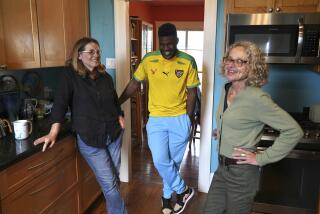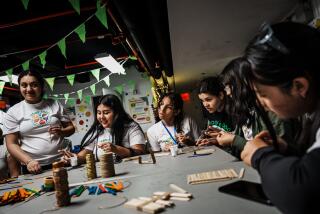All About America in 3 Days
KAKUMA, Kenya — They had learned how to buy bus tokens and clip coupons. Gotten hands-on training for lighting a gas stove and flushing a toilet. Taken a pop quiz on women’s rights.
But for a group of U.S.-bound Somalian immigrants taking a three-day crash course on life in America recently, one topic by far stirred the most buzz: snow.
Staring at pictures of snow-covered roofs and hearing stories about waking up to find a frontyard covered in white, the Somalis (who’d rarely felt temperatures below 60 degrees) peppered the instructor with questions.
“How do I save my family from this ... snow?” asked Hassan Mohammed Abrone, 41, a father of two who was already trying to embrace the American lifestyle by wearing a Statue of Liberty baseball cap and a pair of secondhand Nike Airs.
After hearing a description of coats, scarves, gloves and long underwear, another student, Lelya Yussuf, 23, asked: “How can we walk while wearing all that? Isn’t it too heavy?” In an effort to explain snow to people who have never seen it, the instructor asked students to imagine how it would feel to live inside a refrigerator. But the analogy fell flat for some, because they’d never heard of such an appliance.
“This job takes a lot of patience,” instructor Abdullahinur Sheik Kassim said. “You can’t take anything for granted.”
For the Somalis in this northern Kenya refugee camp, passing a class in America 101 is the final hurdle to boarding airplanes for new lives. As they fly toward the United States, they will learn for the first time where their new homes will be.
A speed-read through American culture, the U.S.-mandated class tries to prepare them for what they will find when they arrive. It covers everything from mini-malls and microwaves to same-sex marriage.
For most of the students, ranging in age from 4 to 65, it’s a steep learning curve. They’ve spent much of their lives fleeing Somalia’s 15-year civil war, scrambling to survive in the bush or toiling in squalid refugee camps. Most come from persecuted ethnic groups and clans, such as the Bantu or Ashraf, that were the first to lose what little property they had after the collapse of Mohamed Siad Barre’s regime in 1991. Now those same injustices have made them eligible to escape to the United States.
The cultural orientation class is one of hundreds given each year in Africa by the International Organization for Migration, or IOM, one of the world’s largest refugee-assistance groups, which organizes the class with funding from the U.S. State Department.
Such programs began in the 1970s for Southeast Asian refugees heading to the United States. Back then, immigrants spent months at transition camps, learning the English language and American customs before entering the country. Over the years, budget cuts have pruned the orientation program to less than a week.
“In just three days, there is not a lot that we can realistically do,” said Pindie Stephen, the group’s regional coordinator for the classes in Kenya. “All we can do is plant the seeds of values and concepts they will encounter later. And we try to dispel myths, because so much of what they learn is from the rumor mill.”
Refugees often believe that life in the U.S. will be easy, that they will live in big homes with cars and television sets. Such descriptions come from relatives in America who sometimes exaggerate their prosperity, or from the U.S.-made TV movies occasionally shown inside refugee camps.
“I know all about America,” said Amal Nuradia, 27. “I’ve seen the Hallmark Channel.” She is among the thousands of Somalian refugees at Kakuma, most of whom fled their country more than a decade ago. More than 12,000 have resettled in the U.S. in recent years.
“What do you know about America?” Kassim asked at the beginning of a recent orientation class. Students yelled out their answers: It’s a superpower. People are always in a hurry. Neighbors don’t talk to each other. Dogs are treated like people. Gay people get married. All children go to school.
With only 15 hours of class, Kassim wasted no time, covering U.S. history in less than 90 seconds. George Washington was the first president. Abraham Lincoln freed the slaves. Martin Luther King Jr. marched for civil rights. Time for the next subject.
Much of the curriculum is based on feedback from recent immigrants. For example, when new immigrants complained about being bewildered by the modern conveniences of a typical American home, IOM built a fully functioning kitchen and bathroom at the back of one classroom. Long flights to the U.S. were so traumatic that a video was added about airplanes, from lavatories to airsickness bags.
Somalian Bantu, who were historically treated like slaves by other groups and lived in mud huts in the bush without water or electricity, usually know little of modern society, needing instruction on such basic tasks as flipping light switches or turning doorknobs. Other students are from more developed urban centers, such as Mogadishu, the Somalian capital, but even they have limited exposure to sights such as skyscrapers, freeways or elevators, and their children have been largely raised on the run or inside refugee camps.
Sensing the students’ anxiety about snow, Kassim spent the next hour explaining U.S. weather. In their textbooks, students read about the importance of punctuality and Americans’ “obsession” with cleanliness.
Of the 25 students, only one spoke English, so Kassim practiced some key English phrases.
“Po-LEESE! Po-LEESE!” the students recited in unison, practicing a 911 call.
Coming from a country without government or law, the idea that help is only a phone call away amazed Yussuf, whose parents were killed and who is traveling to the U.S. alone. “So if anyone bothers me, I just call 911 and the police come and beat them?” she asked. “Life must be very easy.”
Immigrants also heard about U.S. laws. Beating your wife and children is illegal, they were told, and so is chewing khat, the leafy amphetamine-like stimulant popular in Somalia. Performing genital excision on young girls is prohibited.
“If I can’t beat my wife, how will she know that I love her?” Abrone asked, seated next to his silent teenage bride.
Monogamy was equally unpopular with some men, who said their religion permitted four wives. But Kassim shut down the debate. “It doesn’t matter,” he told them. “In the U.S. you’ll barely be able to afford one wife, anyway.”
The second day of class began with an exercise in equality. Students broke into teams and were asked to identify which potential U.S. jobs -- taxi driver, hairdresser or doctor, for example -- were held exclusively by men and which were held by women. It was a trick question, designed to spark a discussion about gender equality.
In one group, Abdi Ahmed Mohammed, 56, a former Mogadishu shopkeeper, grabbed the worksheet and began dividing the occupations by gender.
“Wait,” Yussuf complained. “Why is ‘housekeeper’ female?”
“It’s woman’s work,” Mohammed snapped, checking the box for “female.”
As the instructor began calling on students to defend their answers, it became clear that, at least in the U.S., the correct answer for all jobs was “both.” Mohammed began discreetly erasing his worksheet, and when the instructor asked for his answer for “baby-sitter,” he covered the paper with an arm and answered confidently, “Both.”
The day ended with a tour of the mock kitchen and bathroom. Mohammed ran his fingers over the surface of the gas stove as if it were a shiny new Porsche. Kassim demonstrated how to use a variety of strange Western products, including toothpaste, shampoo and toilet paper.
“Why must I hide behind the curtain in the shower?” one student asked.
“It’s to prevent the water from splashing,” Kassim explained.
Some refugee experts worry that the classes focus too heavily on such basic household lessons.
“They can learn about flushing toilets and riding buses once they get there,” said Hussain Mahmood, head of the Kakuma branch of the Office of the United Nations High Commissioner for Refugees, which also works with Somali refugees. “Instead, I think they’d be better served by a frank discussion about the discrimination and hostilities they may face as Muslims or Africans in the U.S. What’s going to happen when a woman in a scarf meets some skinhead? I’d like to see more about dealing with those cultural challenges.”
By the end of the second day, however, the challenges of living in the U.S. were beginning to sink in for some.
“I’m starting to worry about where I will live and who will take care of my baby when I go to work,” said Fozia Ahmed Hussein Mohammed, 24 and eight months pregnant. Her boyfriend was not eligible to go with her.
“This is going to be more difficult than I thought,” she said.
By the third day, Kassim was scrambling to squeeze in the final lessons. He turned to finances and budgeting. Immigrants might hope to earn $1,000 a month, he told them, but rent for a two-bedroom apartment averages $800, depending upon the area. “One income will not be enough,” he said.
New arrivals get a 30-day assistance package, including help finding a house or apartment, but after that they are expected to find employment. U.S. government relief programs, such as food stamps and welfare, are also available to immigrants.
Kassim concluded with a lesson that left many students in disbelief. He showed them a large chart displaying immigrants’ typical mood swings, first soaring during a “honeymoon” phase, then plummeting during a “depression” and finally settling at a “recovery.”
“At first you will feel as if you’ve gone to paradise,” Kassim said. “Everything is so easy.” But research has shown that later many will experience sadness, loneliness, culture shock and pangs of guilt over friends and family left behind in Africa.
“It’s called stress,” he told them. “You can’t sleep. You watch TV all the time. Some people even kill themselves.” A few students stiffened in their chairs. A couple laughed nervously. It was incomprehensible that they would survive years of hunger and homelessness in Somalia only to commit suicide in one of the richest countries in the world.
“How could we feel depressed there?” Abdi Ahmed Mohammed asked. “After the life we are living, any other life will be better.” Asked for a show of hands of how many believed they might experience stress or sadness, not a single hand went up.
“We do what we can to warn them,” Kassim said after conducting a brief graduation ceremony. “I hope they are ready.”
Outside, graduates clutched their cultural orientation “diplomas,” unable to hide their growing excitement. Some would board airplanes in a matter of days.
Sofia Sharif, 21, was 6 when her village was attacked. Her father was killed; her mother and five siblings disappeared into the bush. Today she is alone in the world, except for a distant older cousin who kept Sharif out of school and forced her to keep house and take care of the cousin’s children.
“If my parents had lived, I might have had the chance to go to school,” Sharif said. “But so what? I’m 21. I’m single. And now I’m going to America.”
*
More to Read
Sign up for Essential California
The most important California stories and recommendations in your inbox every morning.
You may occasionally receive promotional content from the Los Angeles Times.










